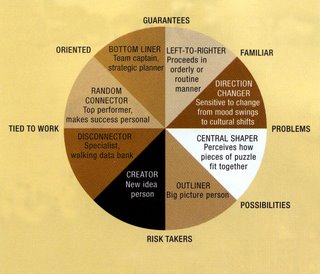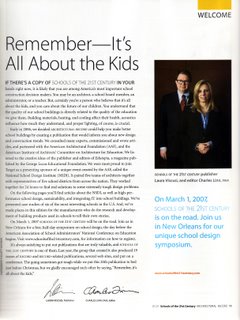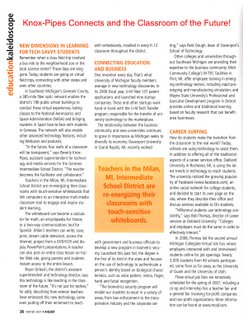Sunday, January 21, 2007
Saturday, January 20, 2007
Thursday, January 18, 2007
THE Drivers of Digital Relevance......YOU!
Kids Today
Researcher Peter Grunwald believes students' increasing taste for technology will transform classrooms.
By Lindsay Oishi
from School CIO
Peter Grunwald is the founder and president of Grunwald Associates, a market research and strategic consulting firm that has been conducting industry-wide surveys on education and technology since 1995 . School CIO recently got Grunwald's perspective on why today's kids are more tech-savvy than ever, and what that means for educators.
Q. How do you think this generation of students is different from previous ones?
A. Kids are taking control of the media they use, whereas the model in previous generations was passive consumption. Students today are producing content themselves, which is reflected in the explosion of personal Web pages, profiles on social networking sites, blogging, podcasts and so on. The whole definition of a cool kid has changed. Now, cool kids are often smart about technology and use it to amplify their voices. From a school's standpoint, this has implications for the expectations about technology that kids bring with them to school.
Q. Your current study investigates students and social networking. What should CIOs be aware of in this domain?
A. There's a lot of focus on the dangers of the Internet and social networking sites in terms of kids connecting with people they ought not to or being exposed to inappropriate content. There is some of that, as there is in a variety of other media. There hasn't been much discussion yet of the educational benefits of social networking. It's hard to predict, but connecting kids in geographically diverse locations to collaborate on projects or learn about each other's realities and cultures can be useful. Multiplayer games and simulations also have educational value. The possibilities are going to become more obvious as the dangers are dealt with or, better yet, put into perspective.
Q. Do new technologies mean that old tools like television have less value?
A. We have found that kids who have the Internet at home are also watching TV, listening to the radio, and talking on the telephone. So the issue becomes how to deal with attention spans that are a product of multitasking. Sometimes that means that kids have shorter attention spans. Or it can mean that the student is used to being in control of where his attention is. That doesn't mean throw out the TV as a deliverer of instructional media. TV is just part of a broader package of technology. The more important matter is understanding the role of all kinds of media in engaging and reaching students.
Q. How can technology be used to engage students?
A. Technology needs to be seamlessly integrated into the classroom rather than making it something that students have to get up and walk to. If I'm playing a game or answering a quiz question, the fact that I'm calling on information that I may have on a handheld device, laptop, or on the Internet becomes less relevant as the technology becomes more robust. Technology as a discrete activity, separate from everyday learning, is going to become less important.
Q. Have you found that school districts use technology more for administrative rather than instructional purposes?
A. I wouldn't want to quantify one over the other. It's easier to figure out, "How can we more accurately record information such as attendance?" The benefits are more readily apparent than the benefits of using technology to help deliver instruction and engage students in the subject area. However, taxpayers and the public think first and mostly of technology's benefits in the classroom. Since taxpayers are significant stakeholders in how schools construct and spend their budgets, it's important to keep in mind that from the public's standpoint, using technology for instruction is the primary consideration.
Q. What advice do you have for CIOs based on your research?
A. What is often most surprising to school district leaders is the importance of supporting and encouraging parental participation in technology decision making. In some ways it's counterintuitive. It means one more set of stakeholders to deal with, which can complicate the decision-making process. But the data is pretty compelling that when it is done intelligently, there is a strong connection between the level of parental participation and the size and health of the technology operation as a whole. It's really all about buy-in. Whenever you are dealing with a constituency, if they feel that they have a stake in the decisions, they'll be much more likely to back technology initiatives.
A "little something" for the Fear Monster in ALL of US!

We Have Nothing to Fear but Fear of Learning
by Marcia Conner
Could you learn more if fear didn't hold you back?
Some people believe they require fear to excel. They count on an adrenalin rush caused by wicked deadlines or overbearing colleagues (or by positive emotions) to push them forward.
Pressure can play a useful role, but stress that's powerful enough to cause fear ultimately shuts us down. Fear causes the amygdalae, regions of the brain, to release the stress chemicals cortisol and vasopressin, putting the body on alert, quickly shutting down higher-order thinking, long-term memory, and our capacity to perform.
Fear constrains performance no matter the setting. While some business leaders blame everything from unmotivated workers to outmoded training departments for lackluster productivity, fear of learning -- actually, fearing what's to be learned -- results in the greatest stagnation. When employees become uncomfortable about learning -- when fear influences how we do our jobs -- it affects the bottom line.
As a coach and educator I see five fears of learning play out: worry over others' opinions, anxiety around changing routines, panic over the possibility of failing, personal distrust around mastering a topic, and terror facing scary stuff. Each fear leads otherwise curious people to avoid exploration and to lose out on learning experiences.
Examine what you fear learning and find a way through.
Feeling Dumb
Do you fear people losing respect for you if you ask questions? Perhaps you believe you'll reveal a terrible secret: You're not as brilliant as you lead everyone to believe.
A colleague who lives near me in Virginia asked an electronics store clerk in Boston to explain how to use an iPod. Some 800 miles from home, she felt less frightened to appear dumb than she did at a local store. She confessed she was deeply uncomfortable recognizing she couldn't grasp a piece of modern life.
If fear of feeling dumb makes you uncomfortable, frame a half-empty answer with something lighthearted. "I thought I knew everything about this field. Great to know I have room to grow. Where can I learn more?" Once you shed a desire to know everything, pressure's off. You can learn from everyone.
More Work
If you expand your knowledge, do you fear people will expect you to put it to use? Learning more might mean extra work. Or it might change comfortable routines. Some people find this so unsettling that they simply stop learning.
Knowledge-transfer guru Steve Trautman (Peermentoring.com) admits he's fearful to learn about the technology in his own house, even though he worked in software for years. He fears that if he does learn about it, his genius wife (who already knows how to make repairs) might expect him to fix things once in while.
Discovery itself doesn't necessitate change. It provides us options to choose from: Do I continue working the same old way, do I want to change everything, or do I pick from what I learned to find a practice that suits me best now?
Failure retry abort
Are there daunting implications about what you yearn to learn? Perhaps your romanticized view of how things should work will be ruined if you discover more.
A gifted guy, on the leading edge of his field, resists marketing himself. He fears success might change him, unsure how he'd maintain his integrity if he became well-known. And he fears the possibility of finding out that people don't care about his work.
Marie Montessori recognized that seemingly simple activities require many steps. Rather than view the areas you fear in total, consider them as small individual parts. Start with a few small activities, a little at a time, then equilibrate, build your momentum, and overcome your fear.
Not Me
Do you fear you can't learn a subject, or maybe you can't learn enough of it? Schools often teach topics from beginning to end, leaving people with the mistaken impression we should (or could) master a full subject in the real world.
I serve on the PR committee for a small community group. A savvy interior designer has created our newsletter for years although she only knows desktop publishing basics. Certain she couldn't learn further, each month she muddled through. When we worked together on a recent newsletter, she made great strides. She recognized she didn't need to learn everything. Rather, she benefited from finding helpful resources. As she learned, she gained self-confidence to learn more.
Because of our unique learning styles and the way information is presented in schools, some of us mistakenly believe that when it comes to learning we're doomed. Not so! Out of school, we can try assorted approaches. If learning from a book bores you, try a simulation, or create for yourself a way to experience the information first-hand.
Danger Danger
Sometimes learning feels too perilous to pursue. Would identifying the creaky noise in the ceiling require you to enter a dark attic with bats? Do you always skip asking the opinion of a coworker who once berated the sweetest person in the office? Informal learning guru Jay Cross (Informal Learning), who has a policy to try almost anything once, tells me he's afraid to attempt rock climbing. He fears if he were having a wonderful time on a rock face, at some point he'd fail to find a crevice and he'd fall to his death. He doesn't want to learn enough to be able to try.
Imagined dangers can hold us back as much as real ones. The emotion center in the brain doesn't distinguish between what it remembers and what it imagines. Catastrophes you envision feel real. FEAR could be an acronym for F-fantasy, E- expectations, A-appearing, R-real. When we don't feel safe, physically or emotionally, we struggle to learn.
If you didn't fear bats or that coworker your queries might instead release brain chemicals that create anticipation, excitement, the thrill of discovery-or little reaction altogether.
Fear Forward
When you fear learning something new try these tactics:
- Say aloud exactly what you fear. "Bob scares me" or "What if I fail?" Daylight makes fear seem less menacing. Then remind yourself that your reaction is natural and you can choose to address it.
- Watch a highlight film. Visualize a mental movie staring you as a capable and competent person who knows he can endure under upsetting circumstances. Pull your clip from past experience or script it from your imagination.
- Walk around the block or down the hall. Physically moving forward helps you feel strong and fit to deal with the situation.
- Create a mantra. Say "I can handle it" to bypass the state triggering your fear.
- Talk about what's stopping you. Tell someone what you need to take action. Perhaps you could use a helping hand, an extra telephone call to check in, or a specific resource or referral.
- Adjust your reaction by unlearning it. While fears can make learning feel difficult, when we truly want to learn something it often seems effortless. Deliberate steps to unlearn our habits can open us to new ways of working.
Acknowledge fear by naming it, relate it to other experiences, recognize how a recent situation differs from past ones, and decide to try a different and new approach. When we gather our fears and then meet them, we can then work our way past them. If we do this enough, we change our feelings about our situation, and we can return to learning again.
Wednesday, January 17, 2007
AIM Entrepreneur's?
| Monday, January 15, 2007 Two Of Three Teens Surveyed Want To Be Self-Employed | |||
| LANSING – Some 70 percent of American teens surveyed recently said they'd like to be self-employed at some point in their lives, with males slightly more inclined than females. JA Interprise Poll on Entrepreneurship said teens also acknowledge that hard work and determination, a college education, and hands-on experience are all important to succeed as an entrepreneur. Of the 1,474 teens responding to the survey, 70.9 percent indicated that they would like to be self-employed at some point in their lives. Male students are more inclined to consider starting a business 77 percent than female respondents, 65.6 percent. Teens with family members or close relatives owning a business are more likely to seek self-employment (77.8 percent) compared to only 64 percent of students with no self-employed family members or relatives. Although more than 70 percent of teens express a desire to become self-employed, most appreciate the challenges that this process entails. Only 8 percent of teens thought that starting their own business would be “very easy” or “easy.” What kind of businesses would teens like to start? “Professional services” - such as an accountant, lawyer, and insurance agent - was the top category selected (32.4 percent), followed by “retail business” (26.3 percent). Teens think that hands-on experience is the best means to learn about a business that they wish to pursue. “Working in the same industry first” was selected by 49.5 percent of teens as the top resource for finding out how to start a business. The Internet was a distant second with 15.3 percent. In reviewing a list of ingredients for business success, students selected “hard work and determination” as their top pick (33.4 percent) for the fifth year. “Leadership and management skills” followed with 25.1 percent. Students are divided on where they can derive the most job security. Self-employment was cited by 36.5 percent as offering the most security, barely surpassing company employment with 35.1 percent. The remaining teens (28.4 percent) indicated a “not sure” on this question. This story was provided by the Small Business Association of Michigan. To learn more, click on SBAM.Org
| |||
Author: Staff Writer Source: Small Business Association of Michigan |
Tuesday, January 16, 2007
Detroit International Auto Show Preview
Monday, January 15, 2007
An "APPLE" A Day!
Apple launches television box and reinvents telephone
Apple has launched an Apple TV box, which promises to do for the television what the iPod did for music. This was somewhat overshadowed by the eagerly anticipated announcement of an Apple iPhone, which virtually reinvents the telephone as an integrated mobile phone, music and video player, with a built-in web browser.
The Apple TV was previously dubbed the iTV, although Steve Jobs, the Apple chief executive, repeatedly referred to it by its former codename as he introduced the product in his keynote presentation at Macworld in San Francisco.

The diminutive Apple TV box connects to a television and allows wireless access to material available on a personal computer or the internet. It enables anyone to browse and view their entire collection of digital media from across the room using a simple and intuitive remote control and on-screen interface. It is also seamlessly integrated with Apple iTunes, enabling selected movies and television shows to be streamed directly over the internet.
The Apple box features a high-definition HDMI output, although this only goes as high as 720p lines, as well as component video and analogue and digital audio.
The power supply is internal, so it can be connected directly to a wall socket without requiring an external transformer, but it does not provide powerline networking. It does however offer an Ethernet port and WiFi networking, including the new draft n standard.
It includes a 40GB hard drive, which is rather too small but no doubt larger versions will follow. It also has an Intel processor, which provides the power for the striking user interface.
The beautiful interface is simply white on black, but is otherwise reminiscent of an iPod, and is typically elegant, sophisticated and simple, with zooming animations.

Apple TV offers access to movies, television shows, music and podcasts through iTunes. It can automatically synchronise material from a designated personal computer on the network and stream from up to five computers. This can include visitors, who can connect their machines wirelessly simply by entering a personal identification code number displayed on the television screen.
Photos can also be easily displayed on a large widescreen display. As Steve Jobs noted, modern digital cameras as are all essentially better than high definition. The display will be limited to 1280x720 resolution, which is less than one million pixels, but it is possible to pan and zoom over images in smooth slideshows.
“We think this is pretty cool,” said Steve Jobs. “I’m really excited by it. We think this is going to be something really quite special.”
The Apple TV will be priced at $299 and will begin shipping in February. While there are many devices that promise to connect the television to a computer network, media centers and similar products have yet to really take off, largely because they are too complex to set up and too difficult to use. Apple could dominate the category with its characteristic consumer appeal and ease of use.
In the long term, devices such as this could begin to bypass cable television operators, with their proprietary set-top boxes, opening up the television to programming that could come from anywhere.
Apple is well placed to enter this market. In addition to two billion songs sold so far on iTunes, it has already sold 50 million television shows and over a million movies.
iPhone
The real excitement, however, was reserved for the long-anticipated announcement of an integrated mobile phone and music player.
“Today Apple is going to reinvent the phone and here it is,” said Steve Jobs, showing an image of an iPod with a rotary dial. He was, of course, only kidding.

The Apple iPhone is undoubtedly a breakthrough device, combining a revolutionary touch screen mobile phone with a music and video player and internet communications. Apple claims that it is five years ahead of anything else on the market and indeed it looks very futuristic.
Apple has developed and patented a gestural touchscreen interface it calls multitouch, which does away with the need for buttons or a special stylus. It scrolls though lists with simple intuitive gestures, rather like a touchpad.
The touchscreen automatically switches off when you bring it to your ear. The 3.5 inch widescreen display automatically detects whether it is in portrait or landscape orientation and it can show true widescreen movies either zoomed full screen or with borders top and bottom. An ambient light sensor adjusts the image to save power.
Apple has taken its usual innovative approach to user interface design to understand how people actually want to use mobile phones, to create an enjoyable user experience.
The phone itself is a quad-band GSM and EDGE device—Apple plans to make 3G phones in the future—and comes complete with WiFi and Bluetooth.
The iPhone runs the OS X operating system and features desktop class applications, including a special version of the Apple Safari web browser which allows full web pages to be displayed and navigated.
Apple is teaming up with Google to offer search and mapping and with Yahoo! to offer free push email, to compete with devices such as the Blackberry.
Steve Jobs was joined on stage by Eric Schmit, the chief executive of Google, who also joins the Apple board, and by Jerry Yang, the co-founder of Yahoo!
The iPhone will be available in the United States from June with Cingular as an exclusive partner and a list price of $499 for a 4GB model and $599 for an 8GB version. It will be available in Europe from the last quarter of 2007 and in Asia the following year.
Apple is aiming to attract a 1% share in 2008—around 10 million units—although it may be expected to exceed that figure.
The iPhone is definitely desirable, but it introduces a number of technical innovations which are not without risk. If it succeeds, it could indeed redefine our view of the mobile phone.
Steve Jobs was evidently excited at his keynote presentation. He said he had been waiting two and a half years for this day and said he had not slept a wink the night before. He compared the launch of the iPhone in importance to that of the iPod in 2001 and the original Mac computer in 1984.
It could be even more significant. With around a billion mobile phones sold last year, the market significantly overshadows that of personal computers, portable music players and games consoles combined.
As a sign of convergence and its emergence as a media and consumer electronics brand, the company is even dropping the word computer from its name, to become simply Apple Inc.
AIM for the "Digital Bling" of the "Clip and Sling!"
Sling helps users share video clips over the internet
CBS television is to trial a new system from Sling Media to enable users to share short segments of programming using a system known as Clip+Sling. The president of CBS was joined by the co-founder of Sling Media to give a demonstration in a keynote presentation at the CES convention in Las Vegas.
“It’s great to be here among all you wikis and mash-ups and avatars,” said Leslie Moonves, the president of CBS Corporation, trying perhaps a little too hard to appear cool. His message was: “There’s no such thing as old or new media anymore. We’re just media.”
He described a symbiotic relationship between the growth of broadband and the transition to digital television, saying “at CBS we’re embracing it big-time.” Sharing the stage with YouTube and Sling Media provided some evidence of that.
“The lesson is those who don’t get in front of the parade end up marching behind it.” He said: The place for any media company serious about the future is right up front, ripping, burning, and mashing up the new beat we’re all marching to.”
“That capability sometimes comes from the most unexpected places, from services that in the past might have been seen as disruptors instead of enablers,” he said. “Part of our job as a major media company is to educate ourselves as to what the audience is capable of,” he suggested, introducing Blake Krikorian, the co-founder of Sling Media.
Sling pioneered the concept of placeshifting and as other companies have moved in to compete it is continuing to innovate around the concept. The popularity of video sharing sites such as YouTube has clearly not gone unnoticed. Capturing and uploading a clip still requires some effort, so Sling Media has decided to make it even easier.
“Now, with our new Clip and Sling functionality I can capture video from my favourite television programming, upload it, and send it to a friend in under 60 seconds,” explained the chairman and chief executive of Sling Media.

Clip+Sling allows Slingbox owners to share material directly from live or recorded television. While customers will need a Slingbox to publish clips, the content posted to an interactive portal will be accessible by anyone. It is designed to make it very easy for those with a Slingbox to share video, while enabling networks and content owners to build communities around their programming. The feature will be built into future versions of the SlingPlayer software.
Sling Media also announced its SlingCatcher product at CES. A Slingbox in reverse, it enables material from a Slingbox, or anything that can be viewed or played on a personal computer, to be received over a wired or wireless network connection and displayed on a television. The SlingCatcher can also download or stream content directly from the internet and display it on a television without the need for a personal computer.
Sling Media is discussing partnership opportunities with large and small content providers to enable them to deliver their programming directly to the television via the SlingCatcher.
Traditional media companies may previously have viewed the sharing and redistribution of their programming as anathema but they are clearly also keen to experiment themselves and embrace the opportunities that it presents.
Thursday, January 11, 2007
Wednesday, January 10, 2007
Wednesday, January 03, 2007
DIGITAL LEARNING Goes GLOBAL
21st Century Digital Job Description
Director, Digital Learning
Duties include: Serve as internal consultant to Content & Product Development teams in the areas of learning styles, training techniques, pedagogy, & curriculum design; lead market research on e-learning technologies, vendors, delivery methods; play critical role in design, presentation, delivery of educational product offerings, & supplemental training tools.
Requirements: Advanced degree preferred w/experience as an instructional designer, educator, learning consultant, or the like. Knowledge of psychometrics, self study, distance learning methodology, e-learning marketplace, & certification testing; strong organizational, project management, & communications skills; ability to work collegially; ability to respond to changing demands; & flexibility to assist team members in meeting other organizational priorities. Financial background a plus.
Reply: 21st Century Digital Learning Environments586.228.0608
E-mail: jross2@earthlink.net










